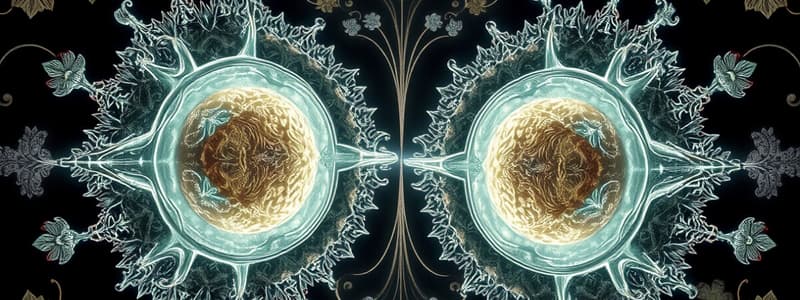Podcast
Questions and Answers
What is the primary purpose of meiosis?
What is the primary purpose of meiosis?
- To double the chromosome number in a cell
- To create four genetically diverse haploid cells (correct)
- To repair damaged cells
- To create two identical diploid cells
During which phase of meiosis II do the sister chromatids separate?
During which phase of meiosis II do the sister chromatids separate?
- Anaphase II (correct)
- Metaphase II
- Prophase II
- Telophase II
What are homologous chromosomes?
What are homologous chromosomes?
- Identical chromosomes from the same parent
- Chromosomes that carry the same genes but may have different alleles (correct)
- Chromosomes that are identical in every way
- Chromosomes that are not related in any way
What results from cytokinesis in meiosis II?
What results from cytokinesis in meiosis II?
Which of the following best describes non-disjunction?
Which of the following best describes non-disjunction?
What is crossing-over during meiosis?
What is crossing-over during meiosis?
What occurs during prophase II of meiosis II?
What occurs during prophase II of meiosis II?
What structure reforms around separated chromosomes during telophase II?
What structure reforms around separated chromosomes during telophase II?
What is the primary purpose of meiosis in sexually reproducing organisms?
What is the primary purpose of meiosis in sexually reproducing organisms?
During which phase of Meiosis I do homologous chromosomes form bivalents?
During which phase of Meiosis I do homologous chromosomes form bivalents?
What occurs during crossing-over in Meiosis I?
What occurs during crossing-over in Meiosis I?
Which statement describes the outcome of Telophase I in meiosis?
Which statement describes the outcome of Telophase I in meiosis?
What is the significance of reducing the chromosome number during meiosis?
What is the significance of reducing the chromosome number during meiosis?
In which phase do the spindle fibers attach to homologous chromosomes?
In which phase do the spindle fibers attach to homologous chromosomes?
What happens to the homologous chromosomes during Anaphase I?
What happens to the homologous chromosomes during Anaphase I?
Which phase of meiosis is primarily responsible for ensuring genetic variability?
Which phase of meiosis is primarily responsible for ensuring genetic variability?
What is the primary purpose of meiosis?
What is the primary purpose of meiosis?
How many daughter cells are produced at the end of meiosis?
How many daughter cells are produced at the end of meiosis?
What occurs during Prophase I of meiosis that increases genetic variation?
What occurs during Prophase I of meiosis that increases genetic variation?
Which of the following statements is true about mitosis compared to meiosis?
Which of the following statements is true about mitosis compared to meiosis?
What chromosome abnormality is associated with Down syndrome?
What chromosome abnormality is associated with Down syndrome?
What type of errors in meiosis can lead to genetic disorders?
What type of errors in meiosis can lead to genetic disorders?
During which phase of meiosis are sister chromatids separated?
During which phase of meiosis are sister chromatids separated?
Which of the following statements is true for both meiosis and mitosis?
Which of the following statements is true for both meiosis and mitosis?
Flashcards are hidden until you start studying
Study Notes
Overview of Meiosis
- Meiosis reduces chromosome number by half, from diploid (2n = 46) to haploid (n = 23).
- Occurs solely in reproductive cells of sexually reproducing organisms.
- Key function: ensures genetic variability and maintains chromosome number across generations.
Phases of Meiosis
Meiosis I: Reductional Division
- Reduces chromosome number from diploid to haploid.
Phases of Meiosis I
-
Prophase I:
- Chromosomes coil and become visible (Leptonema).
- Homologous chromosomes pair (Zygonema), forming bivalents (two homologous chromosomes).
- Crossing-over occurs (Pachynema), ensuring genetic diversity.
- Homologous chromosomes begin to separate; chiasmata become visible (Diplonema).
- Chromosomes fully condense; chiasmata move to ends; nuclear envelope breaks down (Diakinesis).
-
Metaphase I:
- Homologous chromosomes align on the metaphase plate.
- Spindle fibers attach from opposite poles to chromosomes.
-
Anaphase I:
- Homologous chromosomes separate and move to opposite poles.
- Sister chromatids remain attached at the centromere.
-
Telophase I:
- Homologous chromosomes complete migration to poles.
- Nuclear envelope reforms; cytokinesis creates two haploid daughter cells.
Meiosis II: Equational Division
- Similar to mitosis, separates sister chromatids while maintaining haploid number.
Phases of Meiosis II
-
Prophase II:
- Spindle apparatus reforms; chromosomes condense in preparation for division.
-
Metaphase II:
- Chromosomes align on the metaphase plate; kinetochores face opposite poles.
-
Anaphase II:
- Centromeres split; sister chromatids move to opposite poles as individual chromosomes.
-
Telophase II:
- Nuclear envelopes reform around separated chromosomes.
- Cytokinesis occurs, resulting in four non-identical haploid daughter cells.
Key Terms
- Meiosis: Cell division producing four genetically diverse haploid cells from one diploid parent cell.
- Diploid (2n): Cells with two complete chromosome sets (46 in humans).
- Haploid (n): Cells with one complete chromosome set (23 in humans).
- Homologous Chromosomes: Chromosome pairs from each parent, similar in structure and genetic content.
- Synapsis: Pairing of homologous chromosomes.
- Bivalent/Tetrad: Homologous chromosome pair consisting of four chromatids.
- Crossing-over: Exchange of genetic material between homologous chromosomes.
- Chiasma: Points at which homologous non-sister chromatids cross over.
- Nondisjunction: Failure of chromosome separation leading to genetic disorders.
- Cytokinesis: Division of the cytoplasm, resulting in distinct cells.
Key Points to Remember
- Purpose of meiosis: reduce chromosome number and create genetic diversity via recombination.
- Differences between Meiosis I & II:
- Meiosis I reduces chromosome number; Meiosis II separates sister chromatids.
- Errors in meiosis (nondisjunction, translocation, deletion) can lead to significant genetic disorders.
- Crossing-over during Prophase I is vital for genetic variation in offspring, crucial for sexual reproduction.
Comparison: Mitosis vs. Meiosis
- Number of Cell Divisions: Mitosis (1), Meiosis (2).
- Number of Daughter Cells: Mitosis (2), Meiosis (4).
- Genetic Identity: Mitosis (identical to parent), Meiosis (genetically different from parent).
- Chromosome Number: Mitosis (diploid, 46), Meiosis (haploid, 23).
- Location of Occurrence: Mitosis (somatic cells), Meiosis (gametes).
- Timing: Mitosis (throughout life); Meiosis (during sexual maturity).
- Primary Role: Mitosis (growth, repair); Meiosis (sexual reproduction, genetic diversity).
Common Errors in Meiosis
- Nondisjunction: Leads to genetic disorders such as:
- Down Syndrome: Extra copy of chromosome 21.
- Klinefelter Syndrome: Additional X chromosome (XXY).
- Turner Syndrome: Missing X chromosome in females (XO).
Studying That Suits You
Use AI to generate personalized quizzes and flashcards to suit your learning preferences.




